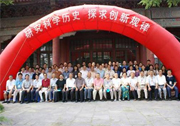| 中文题目: | “日影千里差一寸”观念起源新解 | ||||||
| 英文题目: | |||||||
| 作 者: | 徐凤先 何 驽 | ||||||
| 刊物名称: | 自然科学史研究 | ||||||
| 发表年度: | 2011 | ||||||
| 卷: | |||||||
| 期: | 2 | ||||||
| 页码: | 151-169 | ||||||
| 中文摘要: | 日影千里差一寸的观念在中国天文学史上产生过深远影响。结合考古学和考古天文学的新发现和新的研究结论,并重新分析解读相关历史文献的记载,得出日影千里差一寸的观念当产生于国家建立之际黄河中游两个重要的考古学文化——尧都陶寺和禹都王城岗——的日影观测实践。这两个地点观测到的夏至日影分别为1.6尺和1.5尺,也就是《周髀算经》和《周礼》所记载的两个夏至日影长度;通过对早期长度和距离的分析证明两地之间的直线距离接近当时的1000里。这一时期正是中国文明史上日影测量和大范围地理测量相继开始的特殊时期,由此产生了日影千里差一寸的理论观念。 |
||||||
| 英文摘要: | The idea that the length of the sun’s shadow increases 1 cun for every 1000 li north and decreases 1 cun for every 1000 li south has profound effect in the history of Chinese astronomy. Based on new archaeological and archaeoastronomical discoveries and studies, as well as textual investigations, this paper concludes the idea of 1 cun for 1000 li originated from observations of the sun’s shadow from two important archaeological sites, the Taosi site and the Wangchenggang site, during the critical period when the first state was being formed. The length of the sun’s shadow at summer solstice observed by the dwellers of Taosi site was 1.6 chi (16 cun), and that observed by the dwellers of Wangchenggang site was 1.5 chi (15 cun). The former handed down into Zhoubi suanjing while the latter into Zhouli. Study on the length and distance system of early China demonstrates that the distance between the two sites is very near to 1000 li at that time. It is a special period in Chinese history when measurement of the sun’s shadow and large-scale geographical survey began subsequently, and thus the idea of 1 cun for 1000 li came into existence. |
||||||





